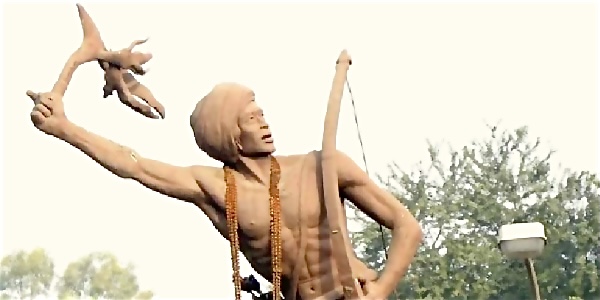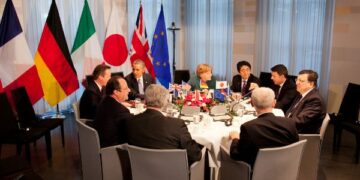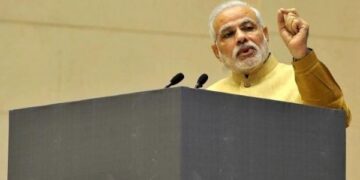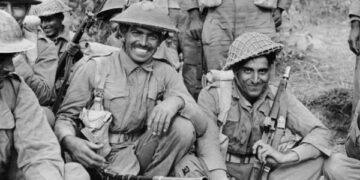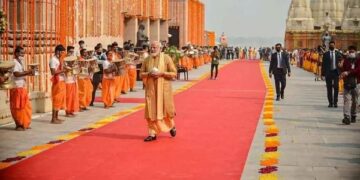Birsa Munda, a tribal independence fighter and religious leader, was born in Ulihatu, Jharkhand, on November 15, 1875. Birsa Munda was a great hero in the Indian independence movement. The Munda Ulgulan is a member of the tribal revolts against British control. We shall learn about Birsa Munda Rebellion, Jayanti, Image & Photo, and his contribution to freedom in this article. As a result, this is an essential topic for the IAS test. So, let’s begin.
Birsa Munda Introduction
Birsa Munda was a tribal leader and Indian freedom fighter who rose up against British oppression. He was a visionary who was instrumental in the emancipation of his people, the tribal people, who had been subjected to British exploitative practices and horrors for a long time. His personal experiences as a young lad, when he moved from place to place in quest of work, gave him insight into the various issues the community faced due to British persecution. He began spreading awareness to reveal the British goal and recruited his army of tribals after discovering that the British corporation had arrived in India to torture the people and export the money.
Why in the News
- On November 15, India will commemorate the birth anniversary (Jayanti) of tribal independence fighter Birsa Munda as Janjatiya Gaurav Divas.
- Narendra Modi opened the Bhagwan Birsa Munda memorial/freedom fighter museum.
- On the 15th of Nov, Prime Minister Narendra Modi paid tribute to tribal hero Birsa Munda on his Jayanti.
- On Munda’s birth anniversary in 2000, the state of Jharkhand, created out of Bihar, became a reality.
The National Monetisation Pipeline (NMP) in India is another significant topic for UPSC aspirants. You can learn about the National Monetization Pipeline in India, the meaning of asset monetization, its relevance, problems, benefits, and other vital information. Now, let us discuss the Birsa Munda Rebellion, Jayanti, photos and images, his legacy, and other topics.
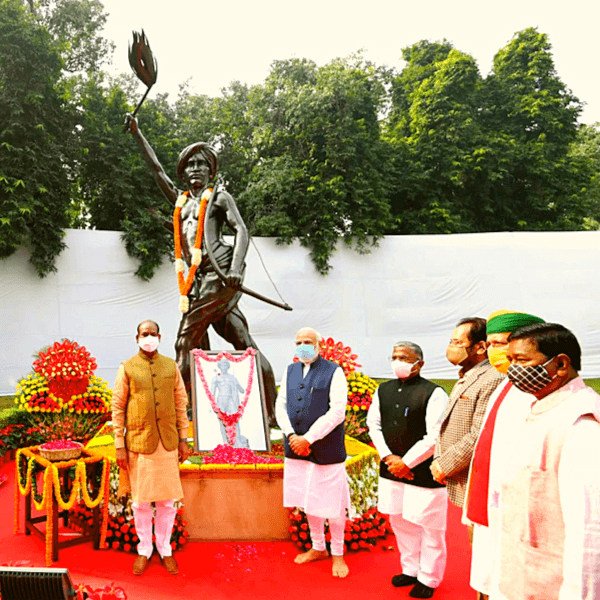
Birsa Munda Early life
- Sugana Munda, an agricultural laborer, & his wife, Karmi Hatu, gave birth to him on November 15, 1875, in Ulihatu, Khunti, Jharkhand, India. He was one of his family’s many children. He has two older sisters, Daskir and Champa, and an older brother, Komta Munda.
- His family was from the Munda ethnic tribe, and they migrated around a lot before settling in Chalkad, where he spent his boyhood. He was always interested in playing the flute since he was a child.
- Birsa Munda moved to his maternal uncle’s hamlet, Ayubhatu, for two years due to poverty. His mother’s younger sister, Joni, was also taken by him to her new home in Khatanga following her marriage.
- He acquired his early schooling at a Jaipal Nag-run school in Salga. Jaipal Nag urged him to attend German Mission School because he was a bright student. As a result, he was converted to Christianity and enrolled in the school as Birsa David. He opted out after a few years of study.
- Birsa founded the ‘Birsait’ creed after becoming aware of the British colonial authority and missionaries’ efforts to convert tribals to Christianity.
- The Birsait cult drew members from the Munda and Oraon communities, posing a challenge to British conversion efforts.
- Birsa Munda also advised the Mundas to quit consuming alcohol, tidy their community, and abandon their beliefs in witchcraft and sorcery.
Birsa Munda Rebellion
- It is one of the world’s most important tribal movements.
- Birsa Munda commanded it in Ranchi’s south from 1899 to 1900.
- According to the movement, the following forces contributed to the Mundas’ disappointment:
- The land policies of the British government were causing damage to the country’s historic land structure.
- Hindu landowners and moneylenders were encroaching on their land.
- The missionaries rebuked their native culture.
The ‘Great Tumult’ or ‘Ulgulan’ (1899-1900)
- Birsa instilled in tribals the principles of love, respect, support, and protection of their homeland against strangers.
- He roused the people by using ancient symbols and language, asking them to kill “Ravana” (dikus and the Europeans) and build a kingdom under his rule.
- He enlisted the help of tens of thousands of tribal people to establish guerilla forces to fight the British Raj.
- Birsa Munda declared that Queen Victoria’s rule was over and that the Munda Raj had begun.
- He issued the raiyats (tenant farmers) orders not to pay rents.
- Police stations and churches were attacked, while moneylenders and zamindars’ properties were plundered. As a symbol of Birsa Raj, they raised the white flag.
- The attacks were not only directed at the moneylender/ landlord/ Mahajan contractor combination but also at the British.
- Hundreds of tribals died for the cause of freedom against the British’s modern ammunition at Dumbri Hill, which became known as the “hill of the dead.”
- The movement’s slogan was “Abua Raj ete jana, Maharani Raj Tundu Jana,” which means “Let the queen’s kingdom cease and our kingdom begin.”
Significance of Munda Rebellion
- Birsa Munda’s political understanding and ability to interact with people constituted the backbone of later nineteenth-century tribal movements.
- He became an icon of the anti-feudal and anti-colonial movement at the time.
- His charismatic demeanor and inspiring remarks inspired others to believe in the power of freedom.
- His rebellious work not only caused damage to British power but it also encouraged tribals to mobilize.
Birsa Munda’s legacy and personal life
- In 1895, he was arrested and released after two years. He continued his armed war with the people in 1899. He destroyed police stations, government buildings, churches, and Zamindars’ homes.
- Birsa Munda was caught by British police on March 3, 1900, while sleeping with his tribal guerilla army in the Jamkopai forest in Jharkhand. Birsa died in prison of cholera, and the movement withered out.
- He met a suitable life partner while residing in the Sankara area of Singhbhum, but he eventually left her due to her dishonesty. He afterward received marriage proposals from two women: Mathura Muda of Koensar’s daughter & Jaga Munda of Jiuri’s wife, but he declined to marry any of them.
- In his honor, several institutes, colleges, and locations have been named after this revolutionary. ‘Birsa Institute of Technology,’ Birsa Munda Athletics Stadium,’ ‘Birsa Agricultural University,’ and the Airport are just a few of the notable ones.
Here are some Tribal Leader Birsa Munda photos and images:
Birsa Munda’s photo and images:

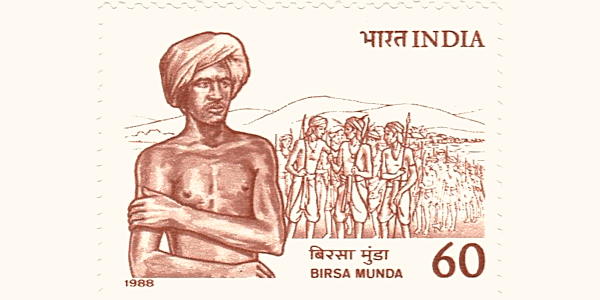

Conclusion- Birsa Munda
In conclusion, this post will assist you in providing all information linked to the Birsa Munda Rebellion. We also discussed Birsa Munda Jayanti, photos/images, his early life, the significance of the Munda rebellion, and his legacy. So read this article slowly and make a list of all the important points for your revision. Also, As previously stated, this topic is critical to your UPSC preparation. Don’t forget to check out the official UPSC website for exams and other details.
FAQ- Birsa Munda
The British colonial system accelerated the transition from a tribal agrarian system to a feudal state. The leaders of Chhotanagpur welcomed the non-tribal peasantry to settle on and cultivate the land because the tribals, with their archaic technology, were unable to produce a surplus. As a result, tribal territories were alienated. Also, Thikadars of the new generation were more voracious, aiming to maximize their wealth.
The day also happens to be the birthday ( Jayanti) of tribal chieftain Birsa Munda, who is regarded as a hero among tribal people. Birsa Munda battled valiantly against the oppressive British colonial system and led a campaign against British oppression, calling for the ‘Ulgulan’ movement (Revolution).
Birsa Munda Airport Ranchi, Birsa Institute of Technology Sindri, Birsa Munda Vanvasi Chattravas, Kanpur, Sidho Kanho Birsha University, Purulia, and Birsa Agricultural University are among the organizations, bodies, and constructions named after him. Birsa Munda Ki Jai is the war cry of the Bihar Regiment.
The importance of “sirmare firun raja jai,” or “victory to the ancestral king,” was instilled in the Adivasis by Birsa, who invoked the tribals’ ancestral autonomous power over the land through the phrase “victory to the ancestral king.” Birsa made history as a mass leader, with his followers referring to him as Bhagwan and Dharati Aba.
On Monday, Prime Minister Narendra Modi announced in Bhopal that the government will now commemorate Birsa Munda’s birthday, November 15, in the same way as Gandhi Jayanti, Sardar Patel’s birthday, and Dr. BR Ambedkar’s birthday are commemorated by the government.
Editor’s Note | Birsa Munda
This article will help you provide all relevant facts on the Birsa Munda Rebellion. Birsa Munda Jayanti, photos/images, his early life, the significance of the Munda rebellion, and his legacy were all mentioned. Furthermore, the initial step in UPSC preparation is to familiarise yourself with the exam syllabus and paper structure. Also, Don’t forget to practice by solving previous year’s papers and mock examinations. To keep up with current events, read the newspaper every day. This will significantly improve your score. Don’t be concerned; instead, start studying for your exam. Have faith in yourself. Finally, best wishes.

